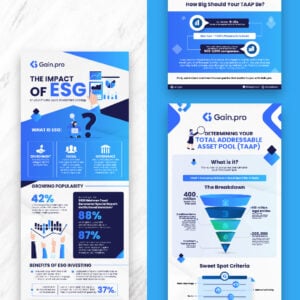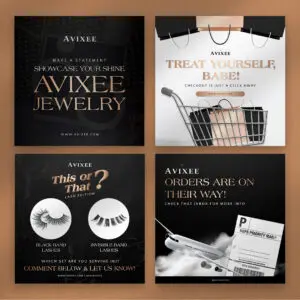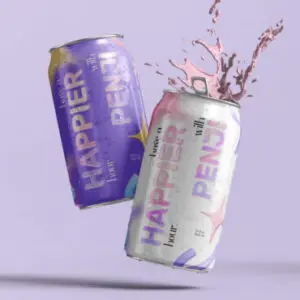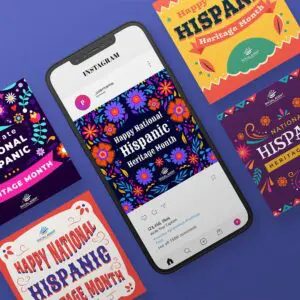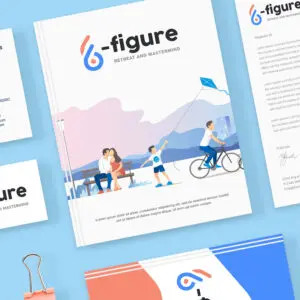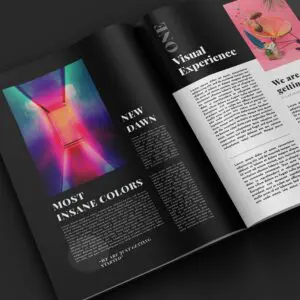
The holidays are notorious for being the time of year that rakes in the most revenue. This is especially true for retail and e-commerce stores, but any business can capitalize on holiday shopping trends. In this post, we’ll look at some eye-opening content marketing statistics so you can plan your holiday business strategy accordingly.

Image Credit: Artem Podrez from Pexels
1. Personalized content creates an average 20% increase in sales opportunities.
Providing highly personalized content is more critical than ever as it significantly impacts sales opportunities. According to the latest DemandGen Report, companies that have successfully deployed lead nurturing initiatives recorded an average 20% increase in sales opportunities. Additionally, 80% of marketers expect a positive ROI when they apply personalization in their campaigns.
To create an effective holiday marketing campaign, you can use personalized content in the following:
- Audience segmentation
- Creating tailored email campaigns
- Customizing website content
- Targeting social media ads
- Recommending personalized products
- Using holiday-themed content
- Encouraging user-generated content
- Engaging customers with interactive quizzes and other promotions.
2. E-commerce accounts for over 19% of global retail sales.
Internet sales have played a pivotal role in the retail business. In 2023, e-commerce accounted for over 19% of retail sales globally. Estimates show that by 2027, the online segment will account to a quarter of total global retail sales.
3. Alibaba’s Taobao and Tmall top gross merchandise value (GMV).
While Amazon remains the top e-commerce platform in traffic, Taobao and Tmall lead GMV share across the web. Run by the Chinese e-retail giant, these platforms provide consumers with business-to-business (B2B), consumer-to-consumer (C2C), and consumer (B2C) e-commerce. In 2022, these platforms accounted for 23 percent of the online GMV. Amazon ranked second, accounting for 12 percent of the overall online GMV.
4. Voice search constitutes at least 20% of all mobile searches.
Voice search currently accounts for almost 20% of all mobile searches worldwide. More people now use voice assistants like Alexa, Siri, and Google Assistants for various tasks, including shopping. This will transform how brands produce content in 2025. Brands must adapt all of their content to consider natural language speech patterns.
But how can you benefit from these recent content marketing statistics? Below are a few tips for using voice search for holiday marketing campaigns:
- Optimize content for local searches: Most voice searches are location-based, so ensure your business is listed on Google My Business and other local directories.
- Use Conversational Keywords: People use natural language when using voice search, so it’s essential to incorporate long-tail keywords and questions into your content.
- Create FAQ Pages: Answer common queries your customers might ask using voice search.
- Optimize for Mobile: Many voice searches are done on mobile devices, so make your website mobile-friendly.
By integrating these strategies, you can better reach customers using voice search to find products and services, especially during the busy holiday season.
5. 90% of marketers using short-form video will increase or maintain their investment.
During the pandemic, most consumers spend their time at home by watching videos, and this trend continues to grow. HubSpot revealed that 90% of short-form video marketers will likely increase their investment this year.
6. Influencer marketing is still prevalent.

Influencers can create content that resonates with audiences, driving higher engagement and conversion rates. That said, more brands choose influencer marketing as part of their content strategy. Customers trust influencers’ recommendations when deciding to make a purchase.
TikTok and Instagram remain the most popular platforms for influencer marketing, while Snapchat is the least popular. Statistically, 33% of Gen Z shoppers have purchased a product because an influencer recommended it. In addition, 89% of marketers who currently use influencer marketing say they want to increase their investment in influencer marketing.
7. Half of all holiday shoppers polled reported a preference for sustainable retail brands.
The importance of sustainability has become painfully obvious. It’s why many brands are already making strides to become more eco-friendly. A sustainability audit is one way to get started. Be sure to share your progress and the authentic results you’ve achieved with your audience. Rather than merely claiming to be sustainable, demonstrate your commitment to sustainability.
8. A survey from Meta showed 29% of shoppers reported finding gifts through influencers during the holidays.
Influencers are an undeniable part of modern culture. Scrolling through social media and shopping have become synonymous. This is why many brands are focused more on integrated marketing than traditional advertising. Today’s consumers generally don’t want to be advertised to. They want to come across great products naturally. Thus, influencers are the perfect facilitators between you and your ideal customer.
9. Image searches are becoming increasingly popular.
Image search is becoming increasingly popular, allowing consumers to search keywords about the image. Visual recognition strategies will continue to grow, with an estimate of image searching becoming a $40 billion industry by 2025.
10. Email Marketing is still considered a popular form of content marketing.

In 2024, B2B technology organizations indicated utilizing email marketing for 44% of their marketing efforts, while email newsletters accounted for 39%. It is effective for brands to create curated newsletters and emails as a part of their marketing strategy.
11. 72% of shoppers scan for discounts and sales when deciding on a big purchase.
If there’s a deal online, most consumers take the time to find it. Especially during the holidays, shoppers know brands are competing for their business. They don’t rush big purchases or simply go with the first offer they see. This is why marketers must ask themselves if they’re really offering the best deal. If not, finding ways to sweeten the pot can mean the difference between a sale and an almost sale.
12. More than 51% of consumers plan to start their holiday shopping before Thanksgiving.
Early Fall might seem too soon to start planning holiday campaigns, but delaying until the clocks change would be a mistake. After all, the early bird catches the worm, especially for holiday marketing campaigns. Likewise, these campaigns require careful planning, so the more time you have, the better results will come together.
Consumers are also getting their holiday shopping out. An intriguing trend is that consumers begin their holiday shopping earlier each year. Although holiday shopping is often linked to Christmas, over 51% of consumers intend to start their holiday shopping before Thanksgiving.
13. Blogging is a timeless marketing tool.
Blog posts are still the most popular format for increasing brand awareness. In fact, 79% of marketers confirm that blog posts effectively distribute content, reach customers, and build brand awareness. This is followed by 56% choosing in-person events and only 15% choosing online learning platforms. So, it is increasingly important to have a strong B2B blog content strategy in place.
14. The podcast has become increasingly popular.

The podcast market is projected to exceed $31 billion by 2025 and grow by 38.91% annually through 2030. This platform has become a preferred medium for many due to its flexibility and the variety of topics it covers. The immersive nature of podcasts and the convenience of mobile apps have fueled this market expansion.
15. Leveraging AI will also continue to increase.
According to HubSpot, 75% of marketers believe that AI-enabled search engines will positively impact their blogs, while 68% predict that their site will get more traffic. Additionally, AI-powered tools can help marketers analyze vast amounts of data, personalize content, and optimize marketing strategies.
Strategies for Holiday Marketing Campaigns
To create a well-organized marketing plan, be sure to mark your calendar with these inspiring content marketing ideas for major holidays:
1. Thanksgiving Marketing
Thanksgiving is all about the spirit of gratitude and thankfulness. You can use this opportunity to show your customers that you are thankful for them by creating a marketing campaign around this theme. This is a perfect chance to express gratitude by offering loyal customers a gift or a holiday-themed giveaway.
Image Credit: Smartrmail
Postmates, a food delivery app, launched an email marketing campaign during Thanksgiving. As you can see, there’s nothing particularly special about this email. Despite its simplicity, this Postmates email design is still very effective. There are clear calls to action, and the text is structured well, which makes the message quick and easy to understand.
2. Black Friday marketing
The next major shopping event is Black Friday, followed by Cyber Monday. Black Friday marketing campaigns are designed to attract bargain hunters seeking the best deals. When executed effectively, these campaigns can contribute up to 25% of a business’s annual revenue.
This Walmart Black Friday promotion will surely inspire you.
Image Credit: Wisestamp
3. Christmas marketing
Christmas marketing is an exciting and crucial aspect of any business’s holiday strategy. Effective Christmas marketing involves creating memorable experiences and encouraging them to engage with your brand.
One of the most iconic examples of successful Christmas marketing is Coca-Cola’s long-standing holiday campaigns. Coca-Cola has perfected the art of festive advertising over the years with proven strategies.
Final Thoughts
The 2025 holiday season is a good opportunity to leverage current and emerging trends to craft compelling campaigns. By applying these content marketing statistics, you can craft your strategies to engage your audience and create memorable holiday experiences. Since we have provided an overview, it’s best to conduct a deeper investigation and choose the best ones that fit your goals.
Partner with a trusted graphic design service like Penji to elevate your holiday marketing. Our team of experts is here to help you create personalized marketing assets. Don’t wait- subscribe to Penji today and start planning your most impactful holiday campaign! Watch this demo to learn more about Penji’s unlimited graphic design services.
About the author

Brianna Johnson
Brianna is a professional writer of 10+ years who specializes in branding, marketing, and technology content.
Table of Contents
- 1. Personalized content creates an average 20% increase in sales opportunities.
- 2. E-commerce accounts for over 19% of global retail sales.
- 3. Alibaba’s Taobao and Tmall top gross merchandise value (GMV).
- 4. Voice search constitutes at least 20% of all mobile searches.
- 5. 90% of marketers using short-form video will increase or maintain their investment.
- 6. Influencer marketing is still prevalent.
- 7. Half of all holiday shoppers polled reported a preference for sustainable retail brands.
- 8. A survey from Meta showed 29% of shoppers reported finding gifts through influencers during the holidays.
- 9. Image searches are becoming increasingly popular.
- 10. Email Marketing is still considered a popular form of content marketing.
- 11. 72% of shoppers scan for discounts and sales when deciding on a big purchase.
- 12. More than 51% of consumers plan to start their holiday shopping before Thanksgiving.
- 13. Blogging is a timeless marketing tool.
- 14. The podcast has become increasingly popular.
- 15. Leveraging AI will also continue to increase.
- Strategies for Holiday Marketing Campaigns
- Final Thoughts
